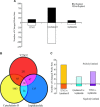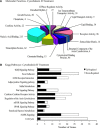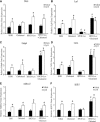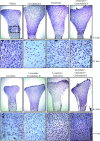Control of chondrocyte gene expression by actin dynamics: a novel role of cholesterol/Ror-alpha signalling in endochondral bone growth
- PMID: 20196782
- PMCID: PMC4516504
- DOI: 10.1111/j.1582-4934.2009.00684.x
Control of chondrocyte gene expression by actin dynamics: a novel role of cholesterol/Ror-alpha signalling in endochondral bone growth
Abstract
Elucidating the signalling pathways that regulate chondrocyte differentiation, such as the actin cytoskeleton and Rho GTPases, during development is essential for understanding of pathological conditions of cartilage, such as chondrodysplasias and osteoarthritis. Manipulation of actin dynamics in tibia organ cultures isolated from E15.5 mice results in pronounced enhancement of endochondral bone growth and specific changes in growth plate architecture. Global changes in gene expression were examined of primary chondrocytes isolated from embryonic tibia, treated with the compounds cytochalasin D, jasplakinolide (actin modifiers) and the ROCK inhibitor Y27632. Cytochalasin D elicited the most pronounced response and induced many features of hypertrophic chondrocyte differentiation. Bioinformatics analyses of microarray data and expression validation by real-time PCR and immunohistochemistry resulted in the identification of the nuclear receptor retinoid related orphan receptor-alpha (Ror-alpha) as a novel putative regulator of chondrocyte hypertrophy. Expression of Ror-alpha target genes, (Lpl, fatty acid binding protein 4 [Fabp4], Cd36 and kruppel-like factor 5 [Klf15]) were induced during chondrocyte hypertrophy and by cytochalasin D and are cholesterol dependent. Stimulation of Ror-alpha by cholesterol results in increased bone growth and enlarged, rounded cells, a phenotype similar to chondrocyte hypertrophy and to the changes induced by cytochalasin D, while inhibition of cholesterol synthesis by lovastatin inhibits cytochalasin D induced bone growth. Additionally, we show that in a mouse model of cartilage specific (Col2-Cre) Rac1, inactivation results in increased Hif-1alpha (a regulator of Rora gene expression) and Ror-alpha(+) cells within hypertrophic growth plates. We provide evidence that cholesterol signalling through increased Ror-alpha expression stimulates chondrocyte hypertrophy and partially mediates responses of cartilage to actin dynamics.
Figures










Similar articles
-
Rac1/Cdc42 and RhoA GTPases antagonistically regulate chondrocyte proliferation, hypertrophy, and apoptosis.J Bone Miner Res. 2005 Jun;20(6):1022-31. doi: 10.1359/JBMR.050113. Epub 2005 Jan 31. J Bone Miner Res. 2005. PMID: 15883643
-
Stromal cell-derived factor 1 regulates the actin organization of chondrocytes and chondrocyte hypertrophy.PLoS One. 2012;7(5):e37163. doi: 10.1371/journal.pone.0037163. Epub 2012 May 18. PLoS One. 2012. PMID: 22623989 Free PMC article.
-
A novel role for GADD45beta as a mediator of MMP-13 gene expression during chondrocyte terminal differentiation.J Biol Chem. 2005 Nov 18;280(46):38544-55. doi: 10.1074/jbc.M504202200. Epub 2005 Sep 2. J Biol Chem. 2005. PMID: 16144844 Free PMC article.
-
Articular Chondrocyte Phenotype Regulation through the Cytoskeleton and the Signaling Processes That Originate from or Converge on the Cytoskeleton: Towards a Novel Understanding of the Intersection between Actin Dynamics and Chondrogenic Function.Int J Mol Sci. 2021 Mar 23;22(6):3279. doi: 10.3390/ijms22063279. Int J Mol Sci. 2021. PMID: 33807043 Free PMC article. Review.
-
Chondrocyte hypertrophy in skeletal development, growth, and disease.Birth Defects Res C Embryo Today. 2014 Mar;102(1):74-82. doi: 10.1002/bdrc.21062. Birth Defects Res C Embryo Today. 2014. PMID: 24677724 Review.
Cited by
-
Inhibition of nuclear receptor RORα attenuates cartilage damage in osteoarthritis by modulating IL-6/STAT3 pathway.Cell Death Dis. 2021 Sep 28;12(10):886. doi: 10.1038/s41419-021-04170-0. Cell Death Dis. 2021. PMID: 34584074 Free PMC article.
-
Effects of ultrasound therapy on the synovial fluid proteome in a rabbit surgery-induced model of knee osteoarthritis.Biomed Eng Online. 2019 Feb 22;18(1):18. doi: 10.1186/s12938-019-0637-2. Biomed Eng Online. 2019. PMID: 30795769 Free PMC article.
-
Regulation of Cholesterol Homeostasis by Hedgehog Signaling in Osteoarthritic Cartilage.Arthritis Rheumatol. 2016 Jan;68(1):127-37. doi: 10.1002/art.39337. Arthritis Rheumatol. 2016. PMID: 26315393 Free PMC article.
-
Identifying the key genes regulating mesenchymal stem cells chondrogenic differentiation: an in vitro study.BMC Musculoskelet Disord. 2022 Nov 15;23(1):985. doi: 10.1186/s12891-022-05958-7. BMC Musculoskelet Disord. 2022. PMID: 36380336 Free PMC article.
-
Regulation of gene expression by PI3K in mouse growth plate chondrocytes.PLoS One. 2010 Jan 25;5(1):e8866. doi: 10.1371/journal.pone.0008866. PLoS One. 2010. PMID: 20111593 Free PMC article.
References
-
- Hunziker EB. Mechanism of longitudinal bone growth and its regulation by growth plate chondrocytes. Microsc Res Tech. 1994;28:505–19. - PubMed
-
- Noonan KJ, Hunziker EB, Nessler J, et al. Changes in cell, matrix compartment, and fibrillar collagen volumes between growth-plate zones. J Orthop Res. 1998;16:500–8. - PubMed
-
- Abad V, Meyers JL, Weise M, et al. The role of the resting zone in growth plate chondrogenesis. Endocrinology. 2002;143:1851–7. - PubMed
-
- Hunziker EB, Schenk RK, Cruz-Orive LM. Quantitation of chondrocyte performance in growth-plate cartilage during longitudinal bone growth. J Bone Joint Surg Am. 1987;69:162–73. - PubMed
-
- Wilsman NJ, Farnum CE, Leiferman EM, et al. Differential growth by growth plates as a function of multiple parameters of chondrocytic kinetics. J Orthop Res. 1996;14:927–36. - PubMed
Publication types
MeSH terms
Substances
Grants and funding
LinkOut - more resources
Full Text Sources
Medical
Research Materials

